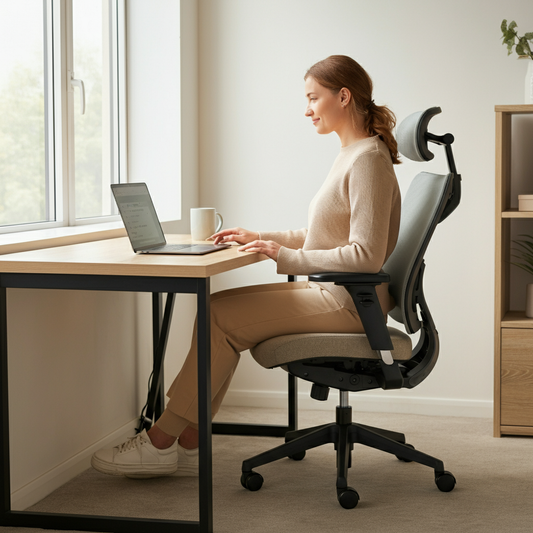Investing in ergonomic office chairs isn’t just about employee comfort—it’s a strategic decision that can significantly impact a business’s bottom line. From reducing absenteeism to boosting productivity, ergonomic seating solutions offer measurable benefits for organisations of all sizes. In this case study, we’ll explore how one company transformed its workplace by introducing ergonomic office chairs, the challenges they faced, and the results they achieved.
The Problem: Discomfort and Absenteeism in the Workplace
1. High Absenteeism Rates
A mid-sized tech company noticed a worrying trend: employees were frequently taking sick days due to back pain, neck strain, and other musculoskeletal issues. This absenteeism was not only affecting productivity but also increasing healthcare costs.
2. Low Employee Morale
Many employees reported feeling uncomfortable and fatigued during long workdays. The lack of proper support from their office chairs was leading to frustration and reduced job satisfaction.
3. Declining Productivity
Discomfort and poor posture were taking a toll on focus and efficiency. Employees found it difficult to concentrate on tasks, leading to missed deadlines and lower overall performance.
The Solution: Introducing Ergonomic Office Chairs
The company decided to address these issues by investing in ergonomic office chairs for all employees. Here’s how they implemented the solution:
1. Assessing Employee Needs
The HR team conducted a survey to understand the specific pain points employees were experiencing. They also consulted with ergonomic experts to identify the features needed in a chair to address these issues.
2. Choosing the Right Chairs
After evaluating several options, the company selected ergonomic office chairs from Lundia’s Ergonomic Office Chairs collection. The chosen models included:
- Adjustable lumbar support for back pain relief.
- 4D armrests to reduce shoulder and neck strain.
- Breathable mesh backrests for improved comfort during long hours.
3. Educating Employees
To ensure employees made the most of their new chairs, the company provided training sessions on proper chair adjustments and workstation setup. This included tips on seat height, armrest positioning, and monitor placement.
4. Monitoring Progress
The company tracked key metrics, such as absenteeism rates, employee satisfaction, and productivity levels, over a six-month period to measure the impact of the new chairs.
The Results: Measurable Improvements in Health and Productivity
The introduction of ergonomic office chairs led to significant improvements across the board. Here’s what the company achieved:
1. Reduced Absenteeism
Absenteeism due to musculoskeletal issues dropped by 40% within six months. Employees reported fewer instances of back pain, neck strain, and fatigue, leading to fewer sick days.
2. Increased Productivity
With improved comfort and support, employees were able to focus better on their tasks. The company saw a 25% increase in productivity, with teams meeting deadlines more consistently.
3. Higher Employee Satisfaction
Employee feedback was overwhelmingly positive. Many reported feeling more comfortable and energised throughout the workday, which boosted morale and job satisfaction.
4. Cost Savings
By reducing absenteeism and improving productivity, the company saved thousands of pounds in lost work hours and healthcare costs. The investment in ergonomic chairs paid for itself within the first year.
Key Takeaways for Businesses
This case study highlights the tangible benefits of investing in ergonomic office chairs. Here are some key takeaways for businesses considering a similar investment:
1. Prioritise Employee Wellbeing
Providing ergonomic seating solutions shows employees that their health and comfort matter. This can improve morale and foster a positive workplace culture.
2. Choose High-Quality Chairs
Invest in chairs with adjustable features and durable materials to ensure long-term benefits. Lundia’s ergonomic office chairs are designed to meet the needs of diverse workforces.
3. Educate Employees
Proper chair adjustments and workstation setup are essential for maximising the benefits of ergonomic seating. Offer training sessions or resources to help employees optimise their workspaces.
4. Track the ROI
Monitor metrics such as absenteeism, productivity, and employee satisfaction to measure the impact of ergonomic interventions. This data can help justify future investments in workplace wellness.
Recommended Ergonomic Chairs from Lundia
If you’re looking to reduce absenteeism and boost productivity in your workplace, Lundia offers a range of ergonomic office chairs designed to meet the needs of modern businesses. Here are some of our top recommendations:
1. Lundia ErgoBoost™ Chair
- Features: Adjustable lumbar support, 4D armrests, and a reinforced base.
- Why It’s Great: Ideal for reducing back pain and improving posture.
2. Lundia ProActive™ Chair
- Features: High-density foam cushioning, breathable mesh backrest, and a compact design.
- Why It’s Great: Perfect for long workdays and shared office spaces.
3. Lundia TeamFit™ Chair
- Features: Wide adjustability range, durable materials, and a sleek design.
- Why It’s Great: A versatile option for teams with diverse needs.
Explore our full range of Ergonomic Office Chairs to find the perfect solution for your workplace.
Why Ergonomic Chairs Are a Smart Investment
Investing in ergonomic office chairs isn’t just about comfort—it’s about creating a healthier, more productive workplace. By addressing the root causes of discomfort and absenteeism, businesses can:
- Improve employee wellbeing and satisfaction.
- Boost focus and efficiency.
- Save money on healthcare costs and lost work hours.
NOTE: This case study synthesises insights from multiple workplace scenarios not a particular company




